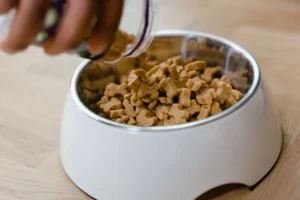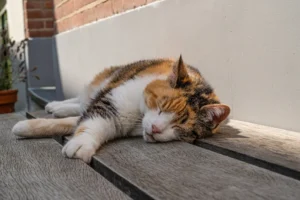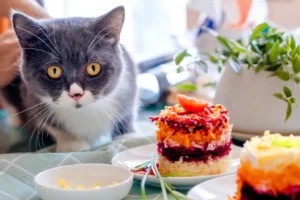Cats are known for their picky eating habits, but have you ever wondered why they can’t eat hot food? Let’s explore the reasons behind this feline sensitivity to temperature.
Cats are designed to eat prey at body temperature, which is why they prefer their food to be room temperature or slightly warm. Here’s a breakdown of why cats should avoid hot food:
Cats’ Sensitive Palates
Cats are known for their finicky eating habits, but did you know they also have extremely sensitive taste buds and tongues? This means that even slightly warm food can be too hot for our feline friends to handle. Their delicate oral tissues are easily burned by hot food, which can lead to discomfort and potential injuries. Just like humans blow on a steaming bowl of soup, cats need their food to be at room temperature or slightly warm to avoid any mishaps.
Potential Health Risks
Feeding your cat hot food may seem harmless, but it can actually pose significant health risks. Cats can easily burn their mouths and throats when consuming hot food, leading to pain, inflammation, and even difficulty eating. This can result in loss of appetite, dehydration, and nutritional deficiencies if not addressed promptly. To prevent these issues, always make sure to allow food to cool down before offering it to your cat. Remember, cats’ delicate mouths are not built to handle hot temperatures, so it’s crucial to prioritize their safety when it comes to mealtime.
Digestive System Differences
Cats have a more sensitive digestive system compared to humans. Their stomach lining is thinner, making them more susceptible to irritation from hot food. When cats consume hot food, it can lead to inflammation, upset stomach, or even burns in the mouth or throat. This is why it’s crucial to let food cool down to room temperature before feeding it to your feline friend. By ensuring their food is not too hot, you can help prevent any digestive issues and keep your cat healthy and happy.
Natural Instincts
In the wild, cats instinctively avoid hot food as it can signal potential dangers. Freshly caught prey is typically warm, while spoiled or rotting food tends to be hot due to bacterial activity. Therefore, cats have evolved to associate hot temperatures with spoilage or contamination. This instinct helps them steer clear of potentially harmful substances. As a pet owner, you can respect this natural instinct by always serving your cat food at an appropriate temperature. By following their instincts, cats can stay safe and healthy in their environment.
Additional Unique Insight:
Cats’ whiskers are not just for show – they are actually highly sensitive and can detect changes in temperature. When food is too hot, cats may feel discomfort not only in their mouth but also through their whiskers. So, if you notice your cat hesitating to eat hot food, it could be because their whiskers are signaling that the temperature is too high. Be mindful of this unique sensory ability when feeding your feline companion.
Alternatives for Feeding
If you’re worried about cats eating hot food, fear not! There are plenty of alternatives to keep your feline friend happy and healthy. 1. Wet Food: Cats generally prefer wet food over dry food, and it’s served at room temperature. 2. Raw Diet: Consider a raw diet for your cat, which can be served at a temperature they prefer. 3. Food Puzzle Toys: These not only slow down your cat’s eating but also provide mental stimulation. 4. Food Toppers: Add some variety to your cat’s meals with food toppers like tuna or salmon flakes. 5. Homemade Treats: Whip up some homemade treats for your cat using cat-safe ingredients. Remember, it’s essential to consult with a veterinarian before making any significant changes to your cat’s diet for their health and well-being.
Interesting Trivia: Cat’s Preference for Texture
Did you know that a cat’s preference for texture plays a significant role in their distaste for hot food? Cats have a unique way of sensing temperature through their whiskers, and hot food might interfere with this sensory ability. They also rely heavily on their sense of touch when it comes to food, preferring smooth textures over hot, mushy ones. This preference for certain textures can make hot food unappealing to cats. So, if you’ve ever wondered why your furry friend turns up their nose at hot meals, it might just be due to their texture preferences playing a role in their dining experience.
Cooling Techniques
Alrighty, so you’ve whipped up a nice meal for your feline friend, but it’s a little too hot to handle for those delicate kitty taste buds. No worries! To cool down their food safely, you can try popping it in the fridge for a few minutes or mixing it with a bit of room temperature water. Another trick is to let it sit for a bit to reach a comfortable temperature. Remember, cats prefer their food at a nice warm or room temperature, not piping hot. Play it safe and cool it down before serving it up!
And here’s a nifty tip: Consider freezing tiny portions of wet food in ice cube trays. It’s a fun and innovative way to cool down their meal while providing a refreshing treat on hot days. Sweet, huh?
Consult Your Veterinarian
So, why can’t fluffy indulge in piping hot noms like us? Well, to put it simply, their sensitive palates can’t handle the heat. Offering your cat food at extreme temperatures can lead to burns in their mouth and esophagus, causing discomfort and potential health issues. To ensure your whiskered buddy’s mealtime is safe and enjoyable, don’t hesitate to consult your veterinarian. They can provide tailored dietary recommendations based on your cat’s specific needs and health requirements. Trust me, a quick chat with your vet can go a long way in keeping your furball happy and healthy.
Alex, a passionate animal lover, has experience in training and understanding animal behavior. As a proud pet parent to two dogs and three cats, he founded AnimalReport.net to share insights from animal experts and expand his knowledge of the animal kingdom.









